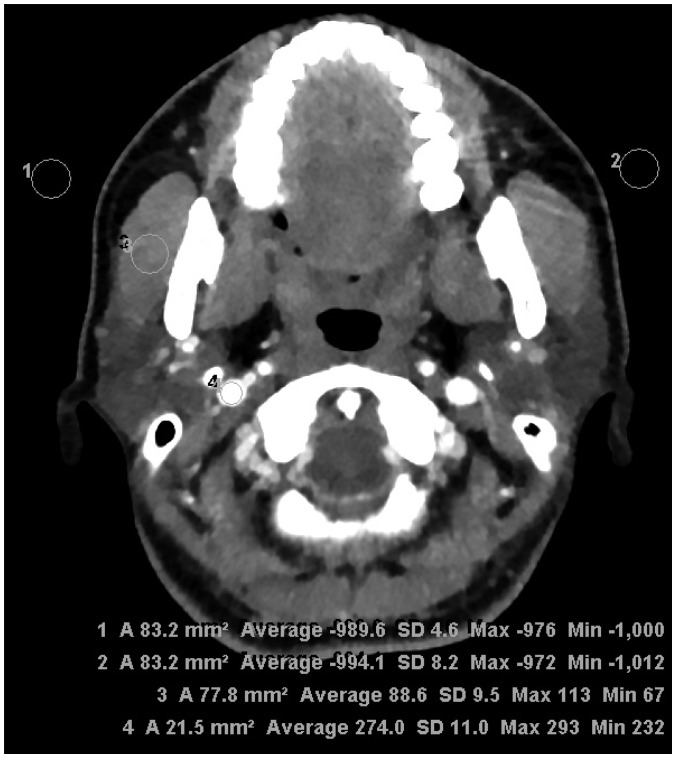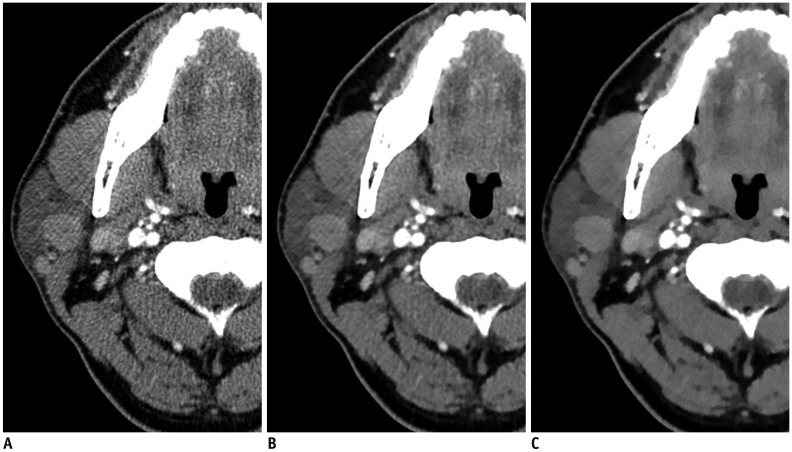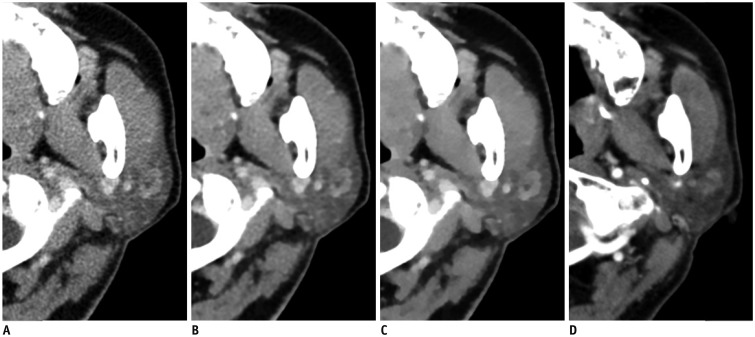Korean J Radiol.
2018 Oct;19(5):957-964. 10.3348/kjr.2018.19.5.957.
Contrast-Enhanced CT with Knowledge-Based Iterative Model Reconstruction for the Evaluation of Parotid Gland Tumors: A Feasibility Study
- Affiliations
-
- 1Department of Radiology, Yonsei University College of Medicine, Seoul 03722, Korea. jinna@yuhs.ac
- KMID: 2418560
- DOI: http://doi.org/10.3348/kjr.2018.19.5.957
Abstract
OBJECTIVE
The purpose of this study was to determine the diagnostic utility of low-dose CT with knowledge-based iterative model reconstruction (IMR) for the evaluation of parotid gland tumors.
MATERIALS AND METHODS
This prospective study included 42 consecutive patients who had undergone low-dose contrast-enhanced CT for the evaluation of suspected parotid gland tumors. Prior or subsequent non-low-dose CT scans within 12 months were available in 10 of the participants. Background noise (BN), signal-to-noise ratio (SNR), and contrast-to-noise ratio (CNR) were compared between non-low-dose CT images and images generated using filtered back projection (FBP), hybrid iterative reconstruction (iDoseâ´; Philips Healthcare), and knowledge-based IMR. Subjective image quality was rated by two radiologists using five-point grading scales to assess the overall image quality, delineation of lesion contour, image sharpness, and noise.
RESULTS
With the IMR algorithm, background noise (IMR, 4.24 ± 3.77; iDoseâ´, 8.77 ± 3.85; FBP, 11.73 ± 4.06; p = 0.037 [IMR vs. iDoseâ´] and p < 0.001 [IMR vs. FBP]) was significantly lower and SNR (IMR, 23.93 ± 7.49; iDoseâ´, 10.20 ± 3.29; FBP, 7.33 ± 2.03; p = 0.011 [IMR vs. iDoseâ´] and p < 0.001 [IMR vs. FBP]) was significantly higher compared with the other two algorithms. The CNR was also significantly higher with the IMR compared with the FBP (25.76 ± 11.88 vs. 9.02 ± 3.18, p < 0.001). There was no significant difference in BN, SNR, and CNR between low-dose CT with the IMR algorithm and non-low-dose CT. Subjective image analysis revealed that IMR-generated low-dose CT images showed significantly better overall image quality and delineation of lesion contour with lesser noise, compared with those generated using FBP by both reviewers 1 and 2 (4 vs. 3; 4 vs. 3; and 3-4 vs. 2; p < 0.05 for all pairs), although there was no significant difference in subjective image quality scores between IMR-generated low-dose CT and non-low-dose CT images.
CONCLUSION
Iterative model reconstruction-generated low-dose CT is an alternative to standard non-low-dose CT without significantly affecting image quality for the evaluation of parotid gland tumors.
Keyword
MeSH Terms
Figure
Reference
-
1. Lin CC, Tsai MH, Huang CC, Hua CH, Tseng HC, Huang ST. Parotid tumors: a 10-year experience. Am J Otolaryngol. 2008; 29:94–100. PMID: 18314019.
Article2. Barrett JF, Keat N. Artifacts in CT: recognition and avoidance. Radiographics. 2004; 24:1679–1691. PMID: 15537976.
Article3. Geyer LL, Schoepf UJ, Meinel FG, Nance JW Jr, Bastarrika G, Leipsic JA, et al. State of the art: iterative CT reconstruction techniques. Radiology. 2015; 276:339–357. PMID: 26203706.
Article4. Halpern EJ, Gingold EL, White H, Read K. Evaluation of coronary artery image quality with knowledge-based iterative model reconstruction. Acad Radiol. 2014; 21:805–811. PMID: 24809321.
Article5. Khawaja RDA, Singh S, Blake M, Harisinghani M, Choy G, Karaosmanoglu A, et al. Ultra-low dose abdominal MDCT: using a knowledge-based iterative model reconstruction technique for substantial dose reduction in a prospective clinical study. Eur J Radiol. 2015; 84:2–10. PMID: 25458225.
Article6. Park SB, Kim YS, Lee JB, Park HJ. Knowledge-based iterative model reconstruction (IMR) algorithm in ultralow-dose CT for evaluation of urolithiasis: evaluation of radiation dose reduction, image quality, and diagnostic performance. Abdom Imaging. 2015; 40:3137–3146. PMID: 26197735.
Article7. Ryu YJ, Choi YH, Cheon JE, Ha S, Kim WS, Kim IO. Knowledge-based iterative model reconstruction: comparative image quality and radiation dose with a pediatric computed tomography phantom. Pediatr Radiol. 2016; 46:303–315. PMID: 26546568.
Article8. Shrimpton PC, Hillier MC, Lewis MA, Dunn M. National survey of doses from CT in the UK: 2003. Br J Radiol. 2006; 79:968–980. PMID: 17213302.
Article9. Jessen KA, Panzer W, Shrimpton PC, Bongartz G, Gelejins J, Tosi G, et al. EUR 16262: European guidelines on quality criteria for computed tomography. Luxembourg: Office for Official Publications of the European Communities;2000.10. Landis JR, Koch GG. The measurement of observer agreement for categorical data. Biometrics. 1977; 33:159–174. PMID: 843571.
Article11. Hu Y, Pan S, Zhao X, Guo W, He M, Guo Q. Value and clinical application of orthopedic metal artifact reduction algorithm in CT scans after orthopedic metal implantation. Korean J Radiol. 2017; 18:526–535. PMID: 28458605.
Article12. Lim HJ, Chung MJ, Shin KE, Hwang HS, Lee KS. The impact of iterative reconstruction in low-dose computed tomography on the evaluation of diffuse interstitial lung disease. Korean J Radiol. 2016; 17:950–960. PMID: 27833411.
Article13. Choi DS, Na DG, Byun HS, Ko YH, Kim CK, Cho JM, et al. Salivary gland tumors: evaluation with two-phase helical CT. Radiology. 2000; 214:231–236. PMID: 10644130.
Article14. Shepp LA, Logan BF. The Fourier reconstruction of a head section. IEEE Trans Nucl Sci. 1974; 21:21–43.
Article15. Seibert JA. Iterative reconstruction: how it works, how to apply it. Pediatr Radiol. 2014; 44(Suppl 3):431–439. PMID: 25304701.
Article16. Hendrick RE. Breast MRI: fundamentals and technical aspects. New York, NY: Springer Science & Business Media;2007.17. Yasaka K, Katsura M, Akahane M, Sato J, Matsuda I, Ohtomo K. Model-based iterative reconstruction for reduction of radiation dose in abdominopelvic CT: comparison to adaptive statistical iterative reconstruction. Springerplus. 2013; 2:209. PMID: 23687632.
Article18. Sidky EY, Pan X. Image reconstruction in circular cone-beam computed tomography by constrained, total-variation minimization. Phys Med Biol. 2008; 53:4777–4807. PMID: 18701771.
Article19. Qi H, Chen Z, Zhou L. CT image reconstruction from sparse projections using adaptive TpV regularization. Comput Math Methods Med. 2015; 2015:354869. PMID: 26089962.
Article20. Mehta D, Thompson R, Morton T, Dhanantwari A, Shefer E. Iterative model reconstruction: simultaneously lowered computed tomography radiation dose and improved image quality. Med Phys Int J. 2013; 2:147–155.




